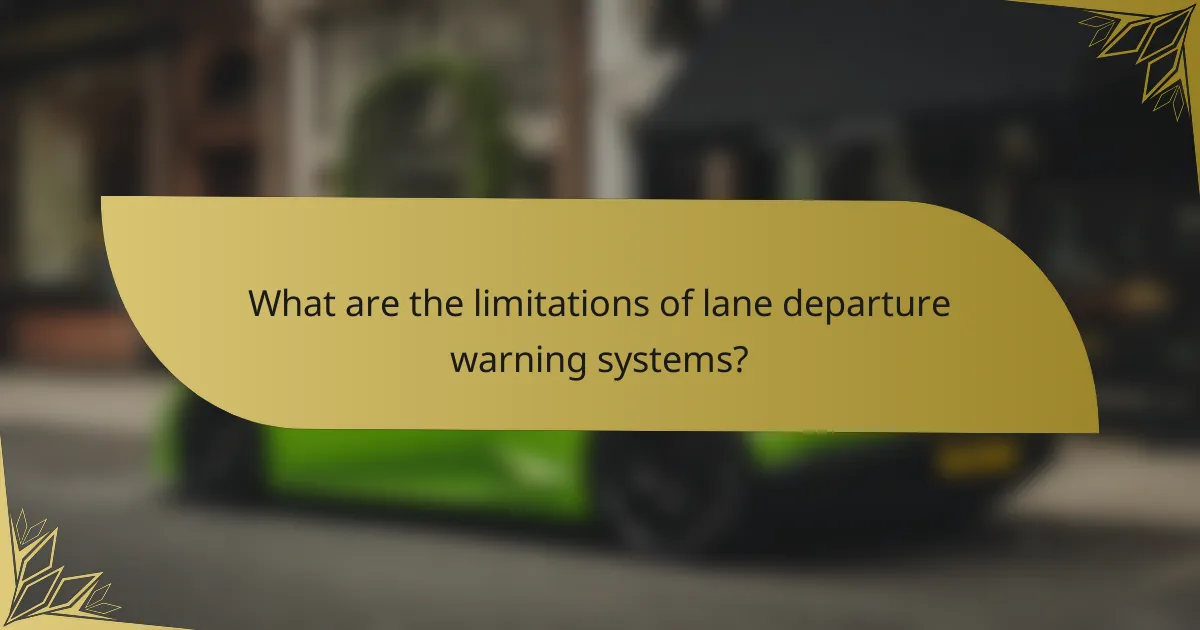Lane departure warning systems (LDWS) are innovative safety features designed to alert drivers when their vehicle drifts out of its lane, significantly enhancing road safety by mitigating risks associated with driver inattention or fatigue. However, these systems face limitations, such as false alarms and varying performance in different driving conditions, which can affect their overall effectiveness. User feedback reveals a blend of satisfaction with the safety benefits and frustration over the system’s shortcomings.

How effective are lane departure warning systems in the United States?
Lane departure warning systems (LDWS) in the United States are effective tools designed to alert drivers when their vehicle unintentionally drifts out of its lane. These systems significantly enhance road safety by reducing the likelihood of accidents caused by driver inattention or fatigue.
Reduction in accidents
Lane departure warning systems contribute to a notable reduction in accidents by providing timely alerts to drivers. Studies indicate that vehicles equipped with LDWS can reduce lane departure-related crashes by approximately 20-30%. This technology is particularly beneficial on highways where the risk of serious accidents is higher.
By alerting drivers before they veer off course, LDWS helps prevent collisions with other vehicles or roadside obstacles. This proactive approach to safety can lead to fewer injuries and fatalities on the road.
Driver response improvement
LDWS enhances driver response by increasing awareness of lane positioning. When drivers receive alerts, they are prompted to correct their steering, which can lead to more attentive driving. This immediate feedback can help mitigate the effects of distractions or drowsiness.
Moreover, regular use of LDWS can improve overall driving habits. Drivers may become more conscious of their lane discipline, leading to safer driving practices over time.
Statistical effectiveness data
Statistical data shows that lane departure warning systems have a significant impact on reducing accidents. Research suggests that vehicles equipped with LDWS experience a reduction in lane departure incidents by about 10-15% compared to those without the system. This effectiveness is particularly pronounced in specific demographics, such as older drivers who may benefit from additional safety features.
Furthermore, the National Highway Traffic Safety Administration (NHTSA) supports the integration of LDWS into vehicles, highlighting its role in enhancing road safety. As more vehicles come equipped with this technology, the overall impact on accident rates is expected to grow.

What are the limitations of lane departure warning systems?
Lane departure warning systems (LDWS) have several limitations that can impact their effectiveness. These include false alarms, reduced performance in specific driving conditions, and the potential for drivers to become overly reliant on the technology.
False alarms
False alarms are a common issue with lane departure warning systems, which can lead to driver frustration. These systems may trigger alerts even when the vehicle is within the lane, often due to road markings that are faded or poorly maintained. Drivers may start to ignore warnings if they perceive them as unreliable, which can undermine the system’s intended safety benefits.
To minimize false alarms, manufacturers are continually improving the algorithms that detect lane markings. However, users should remain vigilant and not solely depend on the system to maintain lane discipline.
Limited effectiveness in certain conditions
Lane departure warning systems may struggle in adverse weather conditions, such as heavy rain, snow, or fog. These conditions can obscure lane markings, making it difficult for the system to accurately detect the vehicle’s position relative to the lanes. Additionally, poorly marked roads or construction zones can further hinder the system’s performance.
Drivers should be aware of these limitations and exercise caution in challenging conditions. It’s advisable to manually steer and remain attentive, especially when road visibility is compromised.
Driver over-reliance
Over-reliance on lane departure warning systems can lead to complacency among drivers. Some may assume that the technology will always prevent lane departures, which can result in reduced attention to the road. This mindset can be particularly dangerous in complex driving situations, such as merging or navigating curves.
To counteract this tendency, drivers should view LDWS as an assistive tool rather than a substitute for active driving. Regularly practicing safe driving habits and maintaining full control of the vehicle is essential for overall road safety.

What user feedback is available on lane departure warning systems?
User feedback on lane departure warning systems (LDWS) highlights a mix of satisfaction and concerns. Many drivers appreciate the added safety features, while others express frustration over false alarms and system limitations.
User satisfaction ratings
User satisfaction with lane departure warning systems generally falls within a moderate to high range. Surveys indicate that around 70-80% of users feel more secure with LDWS in their vehicles. The systems are often praised for their ability to prevent unintended lane changes, particularly during long drives.
Common complaints
Real-world experiences

How do lane departure warning systems compare to lane keeping assist?
Lane departure warning systems (LDWS) alert drivers when they unintentionally drift out of their lane, while lane keeping assist (LKA) actively helps steer the vehicle back into the lane. Both technologies enhance road safety, but they function differently and serve distinct purposes.
Functionality differences
Lane departure warning systems primarily focus on monitoring lane markings and notifying the driver through visual or auditory alerts when the vehicle strays. In contrast, lane keeping assist goes a step further by automatically adjusting the steering to help keep the vehicle centered in its lane. This proactive intervention can significantly reduce the risk of unintentional lane departures.
LDWS typically does not intervene in vehicle control, relying instead on the driver to take corrective action. LKA, however, can engage the steering system, which may lead to a more seamless driving experience, especially on highways or long stretches of road.
Safety implications
Both systems contribute to improved safety by reducing the likelihood of accidents caused by lane drifting. LDWS can enhance driver awareness, prompting them to stay focused on the road. However, since it relies on driver response, its effectiveness can vary based on the driver’s attentiveness.
Lane keeping assist can provide a higher level of safety by actively preventing lane departures, which is particularly beneficial in situations where the driver may be fatigued or distracted. However, over-reliance on LKA may lead to complacency, so drivers should remain engaged and attentive at all times.
Cost comparisons
The cost of lane departure warning systems is generally lower than that of lane keeping assist features. LDWS can be found in many vehicles as part of standard safety packages, often priced in the low hundreds of USD. In contrast, lane keeping assist systems may add several hundred to over a thousand USD to the vehicle’s price, depending on the manufacturer and technology sophistication.
When considering the total cost of ownership, it is essential to weigh the benefits of enhanced safety against the additional expense. For those prioritizing safety features, investing in lane keeping assist may be worthwhile, while budget-conscious consumers might opt for the more affordable lane departure warning systems.

What factors should be considered when choosing a lane departure warning system?
When selecting a lane departure warning system, consider vehicle compatibility, system reliability, and cost-effectiveness. These factors will significantly influence the system’s performance and overall value for your driving experience.
Vehicle compatibility
Ensure that the lane departure warning system is compatible with your vehicle’s make and model. Some systems are designed specifically for certain brands or types of vehicles, while others may be more universal. Check the manufacturer’s specifications to confirm compatibility.
Additionally, consider whether the system integrates with existing safety features in your vehicle. Systems that work seamlessly with adaptive cruise control or lane-keeping assist can enhance overall functionality and safety.
System reliability
Reliability is crucial for lane departure warning systems, as false alerts or failures can lead to driver frustration or, worse, accidents. Look for systems that have undergone rigorous testing and meet safety standards, such as those set by the National Highway Traffic Safety Administration (NHTSA).
Read user reviews and expert assessments to gauge real-world performance. Systems that consistently receive high ratings for accuracy and responsiveness are generally more trustworthy.
Cost-effectiveness
Evaluate the cost-effectiveness of lane departure warning systems by comparing features against their price. Systems can range from a few hundred to over a thousand dollars, depending on their capabilities and brand reputation.
Consider the long-term benefits, such as potential reductions in accident-related costs and insurance premiums. Investing in a reliable system may save money in the long run, especially if it enhances your vehicle’s safety profile.

What are the future trends in lane departure warning technology?
Future trends in lane departure warning technology focus on enhancing safety through better integration with autonomous systems, improved sensor capabilities, and evolving regulations. These advancements aim to create a more reliable driving experience while addressing the limitations of current systems.
Integration with autonomous driving
As vehicles move towards greater automation, lane departure warning systems are increasingly being integrated with autonomous driving features. This integration allows for real-time data sharing between systems, enabling vehicles to make more informed decisions about lane positioning and navigation.
For example, a fully autonomous vehicle may use lane departure warnings not just to alert the driver but to actively steer the vehicle back into the lane. This shift from passive alerts to active intervention represents a significant advancement in driving technology.
Advancements in sensor technology
Recent developments in sensor technology are enhancing the accuracy and reliability of lane departure warning systems. Newer sensors, such as high-resolution cameras and LIDAR, provide better detection of lane markings and road conditions, even in challenging environments like poor weather or low light.
These advancements can lead to more responsive systems that minimize false alerts and improve overall safety. For instance, systems equipped with advanced sensors can detect subtle changes in lane markings, allowing for smoother operation and better driver assistance.
Potential regulatory changes
As lane departure warning systems become more prevalent, regulatory bodies may implement new standards to ensure their effectiveness and safety. These regulations could mandate specific performance benchmarks for lane departure systems, influencing how manufacturers design and implement these technologies.
In Europe, for instance, the European Union has been pushing for stricter vehicle safety regulations, which may include requirements for advanced driver assistance systems like lane departure warnings. Staying informed about these potential changes is crucial for manufacturers and consumers alike, as they could impact vehicle features and safety ratings.
